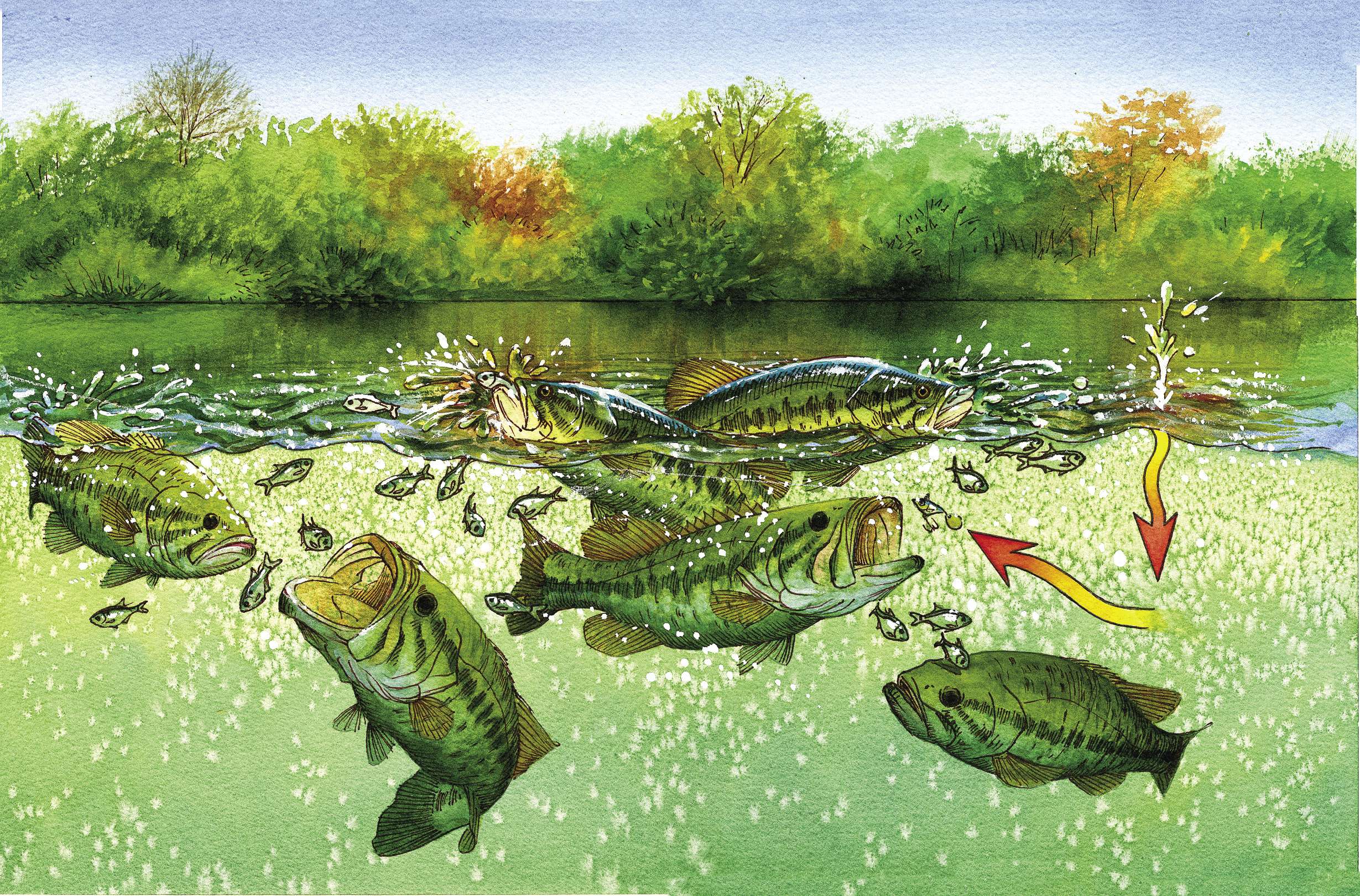
In a tail spin, you say? Back in the 1970s, every bass angler’s tacklebox had several 1/2- or 3/4-ounce compact, teardrop-shaped lead body baits with a single treble hook and a rotating Colorado blade for a tail. The original one – the Little George – was created by famed angler and lure maker Tom Mann of Alabama. Even back then, when anglers discovered a good thing, it didn’t take long for imitations to appear, and soon there were numerous copies on the market.
However, as bass lures became more sophisticated in the ensuing decades, the simple tailspinner apparently didn’t have enough ”bling” to maintain a top ranking. Yet, a handful of fishermen continued to use the bait religiously. Without a doubt, the tailspinner – when presented properly – still catches bass today.
Perhaps no angler on the Bassmaster Elite Series these days knows more about tailspinners than Pete Ponds of Mississippi. “I was raised fishing tailspinners because my Dad made them. To this day, it remains an important lure in my arsenal.”
Pete’s dad, Bob Ponds, fished early Bassmaster tournaments, including the first Bassmaster Classic. Like Mann, Bob was a tackle innovator. Bob loved fishing the Little George but lost fish when a bass would shake its head. The heavyweight body affixed to the hook gave bass leverage to throw the bait. So, in the interest of a better mousetrap, Bob came up with the Wing Ding in 1969 — a tailspinner with the line passing through a center hole in the body and tied to a treble hook, allowing the lead to slide up and down the line like a slip sinker.
“Even though I’ve tried many different copies over the years, the original Wing Ding is the tailspinner that has proven itself time and time again,” Pete says. “Dad sold the company some years ago and modifications were made to the Wing Ding, so I ardently guard my remaining supply of original ones. I would not feel totally prepared for a tournament if tailspinners weren’t in the boat.”
With sliding-body models, such as the Wing Ding, Pete pegs the body to the line lightly with a toothpick, which still allows the bait to move away from the hook when a fish slams it.
Of course other Elite Series pros know the magic of tailspinners, too, including Bassmaster Classic winner Boyd Duckett. “In a tackle market filled with fancy lures, not a lot of fishermen use the tailspinner these days. But I do! I find them highly effective in certain situations.
“Until about a year ago, the one I used almost exclusively was the McSpin out of California. Then I was introduced to Sebile Spin Shad. This new bait has filled a niche in my tailspinner patterns when larger profile baits are desired for ledge fishing on big bass waters such as Lake Eufaula and Kentucky Lake. Meanwhile, the McSpin gets the nod for clear water lakes with suspended bass and smaller baitfish.”
Both Elite pros favor natural preyfish patterns. The vibrating, flashing tail blade coupled with baitfish hues are triggering factors for bass.
CUTS ON RIVER LAKES
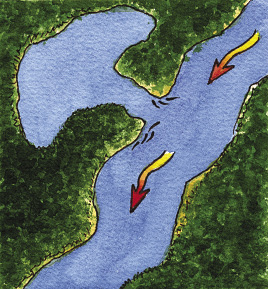 Ponds: A favorite summertime pattern with a tailspinner involves cuts leading from the river to oxbow lakes, such as those that occur on Alabama’s Neely Henry Reservoir, Mississippi’s Ross Barnett and others. On each corner where the narrow creek cut joins the reservoir, largemouth bass will position themselves to feed when a mild current is generated. On the upstream corner, bass are usually just inside the cut; on the downstream corner, bass typically position just outside the cut along the bank. Throw the tailspinner into shallow water and work it with the current down the slope, lifting and dropping it as if retrieving a plastic worm. Start with the rod at 9 o’clock and pump the rod to 12 o’clock; hold the rod at 12 until the lure hits bottom. Most of the time bass hit the tailspinner on the drop, so be ready! You don’t set the hook with a traditional sweep, but by reeling quickly as soon as a strike is detected.
Ponds: A favorite summertime pattern with a tailspinner involves cuts leading from the river to oxbow lakes, such as those that occur on Alabama’s Neely Henry Reservoir, Mississippi’s Ross Barnett and others. On each corner where the narrow creek cut joins the reservoir, largemouth bass will position themselves to feed when a mild current is generated. On the upstream corner, bass are usually just inside the cut; on the downstream corner, bass typically position just outside the cut along the bank. Throw the tailspinner into shallow water and work it with the current down the slope, lifting and dropping it as if retrieving a plastic worm. Start with the rod at 9 o’clock and pump the rod to 12 o’clock; hold the rod at 12 until the lure hits bottom. Most of the time bass hit the tailspinner on the drop, so be ready! You don’t set the hook with a traditional sweep, but by reeling quickly as soon as a strike is detected.
LEDGE FISHING
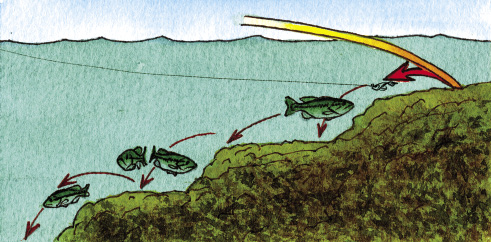 Duckett: When fishing offshore ledges on reservoirs such as Kentucky Lake and Lake Eufaula, I like the larger profile of the Sebile Spin Shad, which better represents a larger baitfish profile to big bass. Also, the Spin Shad has a different blade action than the traditional tailspinner. The elongated blade has more of a wild flutter than the rotating hard thump of a Colorado; the flash is more like a jigging spoon. Cast the Spin Shad to the shallower edge and work it down the ledge. Let it hit bottom, and then lift it with the rod. Hold the rod and let the Spin Shad fall. Anticipate the bottom and lift the lure again just before it hits. But, you should bump bottom every now and then to make sure you are still within six inches of the bottom.
Duckett: When fishing offshore ledges on reservoirs such as Kentucky Lake and Lake Eufaula, I like the larger profile of the Sebile Spin Shad, which better represents a larger baitfish profile to big bass. Also, the Spin Shad has a different blade action than the traditional tailspinner. The elongated blade has more of a wild flutter than the rotating hard thump of a Colorado; the flash is more like a jigging spoon. Cast the Spin Shad to the shallower edge and work it down the ledge. Let it hit bottom, and then lift it with the rod. Hold the rod and let the Spin Shad fall. Anticipate the bottom and lift the lure again just before it hits. But, you should bump bottom every now and then to make sure you are still within six inches of the bottom.
SANDBARS ON RIVER LAKES
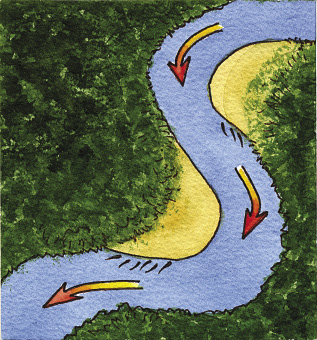 Ponds: On snaking river reservoirs, on an outside channel turn, you’ll see a deeply cut bank. But on the inside of that turn will be a flat — usually a sandbar with a gradual taper formed by the current depositing debris. On the downcurrent side of the sandbar flat, just as it’s about to go into another outside turn, will be the steepest break — typically this is where largemouth and spotted bass hold during the late summer and early fall. Throw upstream onto the flat, let the bait fall to bottom and use a pumping retrieve to work the tailspinner back to the boat. The “pump” is similar to stroking a jig, but not quite as aggressive. It’s important to keep slack out of the line so you can feel the bite.
Ponds: On snaking river reservoirs, on an outside channel turn, you’ll see a deeply cut bank. But on the inside of that turn will be a flat — usually a sandbar with a gradual taper formed by the current depositing debris. On the downcurrent side of the sandbar flat, just as it’s about to go into another outside turn, will be the steepest break — typically this is where largemouth and spotted bass hold during the late summer and early fall. Throw upstream onto the flat, let the bait fall to bottom and use a pumping retrieve to work the tailspinner back to the boat. The “pump” is similar to stroking a jig, but not quite as aggressive. It’s important to keep slack out of the line so you can feel the bite.
MAIN-LAKE ROCKY POINTS
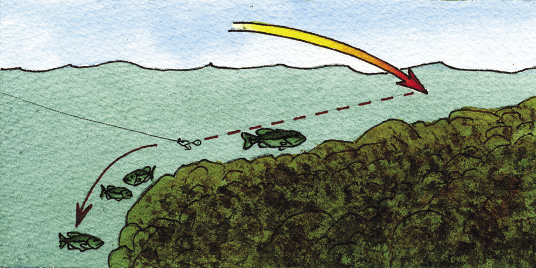 Ponds: An overlooked tailspinner presentation for northern lakes is on long, rocky points. The best situation is an extended, well-defined point with the steepest break at the tip. With the boat positioned deeper than the dropoff, make a long cast onto the shallower part of the point. Reel the bait at a steady, medium-slow pace so it swims along the contour of the point. When the tailspinner reaches the major break, let it drop to the bottom — but keep contact with the bait. If the swimming retrieve does not produce, try pumping the tailspinner down the point, bumping bottom between pumps.
Ponds: An overlooked tailspinner presentation for northern lakes is on long, rocky points. The best situation is an extended, well-defined point with the steepest break at the tip. With the boat positioned deeper than the dropoff, make a long cast onto the shallower part of the point. Reel the bait at a steady, medium-slow pace so it swims along the contour of the point. When the tailspinner reaches the major break, let it drop to the bottom — but keep contact with the bait. If the swimming retrieve does not produce, try pumping the tailspinner down the point, bumping bottom between pumps.
FREE-ROAMING SCHOOLS
Ponds: In the late summer and early fall, nomadic schools of bass will chase shad near the surface. Many bass groups simply keep following the baitfish, pushing the shad to the surface and attacking. Since these bass are not relating to structure, they are referred to as gypsy schools. By watching a sequence of jumps, you can usually tell the direction the bait and fish are moving. Position the boat so you can cast ahead of the school. The tailspinner is absolutely the best for this situation because it casts like a bullet. When the bass attack, cast beyond the action, reel the bait into the path of the last observed jump, and let the tailspinner drop. Bass shadowing the bait will nail it instantly.
SUSPENDED BASS
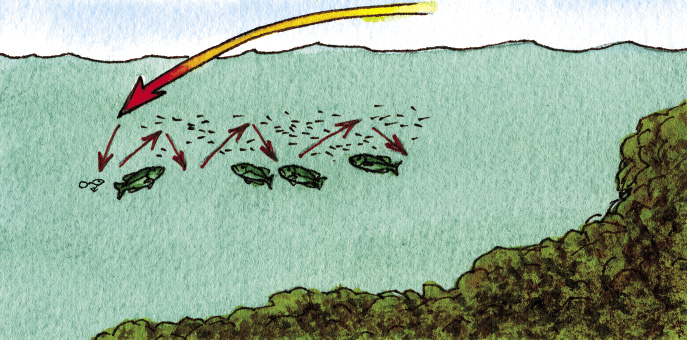 Duckett: The McSpin is awesome in the open water of clear lakes. Taking the Alabama Rig out of the equation, the tailspinner is perhaps the best lure to catch suspended bass in the late summer, fall and winter. This is an electronics deal: First find suspended baitfish schools, and then look for larger arches. Cast the tailspinner beyond the fish, count it down to the desired depth and yo-yo it back through the fish. Don’t rip the McSpin, but employ a lift and drop. Always let it fall on a tight line in order to detect a strike. In order to keep the bait in the zone, the drop should be about 2 feet before lifting again.
Duckett: The McSpin is awesome in the open water of clear lakes. Taking the Alabama Rig out of the equation, the tailspinner is perhaps the best lure to catch suspended bass in the late summer, fall and winter. This is an electronics deal: First find suspended baitfish schools, and then look for larger arches. Cast the tailspinner beyond the fish, count it down to the desired depth and yo-yo it back through the fish. Don’t rip the McSpin, but employ a lift and drop. Always let it fall on a tight line in order to detect a strike. In order to keep the bait in the zone, the drop should be about 2 feet before lifting again.
Tailspinner Directory
Tailspinners are one of those lures that lends itself to “cottage manufacturing” with regional baits offered across the U.S. Visit a local tackle shop at a particular lake where tailspinners are popular, and you may find several different baits for sale that are found nowhere else. But in terms of nationwide offerings by major companies, the selection of tailspinners is somewhat limited. The McSpin mentioned by Boyd Duckett may no longer be available; no website or point of sale could be located, and the email address provided by Duckett is no longer active. Some of the following tailspinners you will find in tackle shops around the country, while others are only available from websites.
- Bass Pro Shops Tail Spin | www.basspro.com
- Bayou Tackle BT Tail Spinner | www.bayoutackle.com
- Punisher Lures Little Sparkie | www.punisherlures.com
- ReelBait Tackle Co. Lytle’s Secret Tail | www.reelbait.com
- Mann’s Little George | www.mannsbait.com
- Markey’s Tommy Tailgunner | www.markeylure.webs.com
- Norman Lures Knock Off | www.normanlures.com
- Revenge Tail Spinner | www.revengebaits.com
- Sebile Spin Shad | www.sebileusa.com
- Wahoo Lures Wing Ding | www.wahoofishingproductsinc.com
Originally published August 2012




